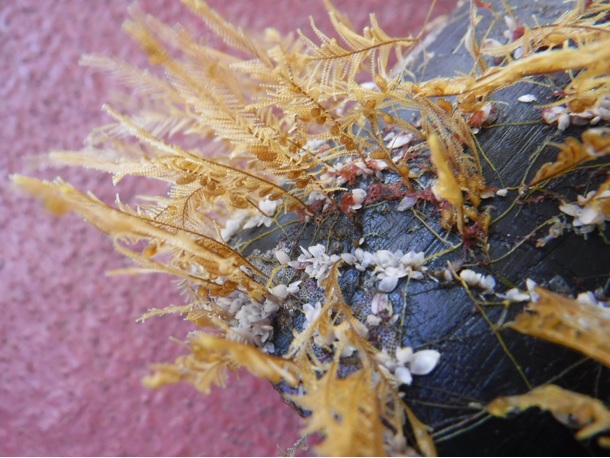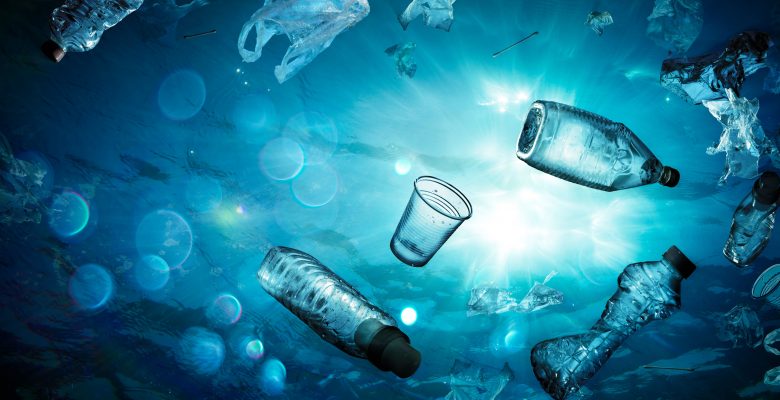Coastal plants and animals have found a new way to reproduce in the open ocean by colonising plastic debris. Tough rafts created by a pile of detritus allow many coastal marine invertebrates to drift through the oceans. These movements could eventually pose an increased risk of invasive species proliferation.
written by Laurie Henry
Scientists already suspected that coastal species could use plastic to survive in the open ocean for long periods. Between 2012 and 2017, researchers found that nearly 300 species had crossed the Pacific on debris from the 2011 Japanese earthquake. But until now, confirmed sightings of coastal species on plastic directly in the open ocean have been rare.
70 % of debris colonised by species
SERC researchers found coastal species on more than 70% of the 105 plastic samples collected in the North Pacific Ocean by The Ocean Cleanup during their 2018 and 2019 expeditions. The number of coastal species collected even surpassed that of open ocean species.
The scientists pointed to the ease with which these traditionally nearshore species have colonised new floating objects, including their own instruments – an observation they intend to pursue with further research. These results point to a new human-induced impact on the ocean, documenting the magnitude and potential consequences that were not previously understood.
Lead author Linsey Haram, a research associate at SERC, says in a statement: “This discovery suggests that ancient biogeographic boundaries between marine ecosystems – established millions of years ago – are rapidly changing as a result of floating plastic pollution accumulating in the subtropical gyres.
« Rubbish patches » across the oceans
This incredible phenomenon was observed hundreds of kilometres offshore in the North Pacific subtropical gyre. An ocean gyre is a large system of circular ocean currents formed by the interplay of global winds and the forces created by the Earth’s rotation. These gyres surround large areas of calm, stationary water. Debris drifts into these areas and, due to the lack of movement in the region, can accumulate for years, forming “rubbish patches”.
There are at least five plastic-infested gyres in the world. The North Pacific subtropical gyre, located between California and Hawaii, is the largest accumulation of ocean plastic in the world. It contains an estimated 79,000 metric tons of floating plastic over an estimated area of 1.6 million square kilometres, twice the size of Texas or three times the size of France.
Much of this pollution is made up of microplastics, which are too small to be seen with the naked eye. Floating debris such as nets, buoys and bottles carry with them organisms that normally live on the coast. These new communities of organisms are called “neopelagic”. “Neo’ means new and ‘pelagic’ refers to the open ocean, as opposed to the coast.

Coastal species, including gooseneck barnacles, found in the high seas on plastic collected in the North Pacific subtropical gyre. © The Ocean Cleanup, in coordination with Smithsonian Institution
Plastic rafts: a new threat to biodiversity
Rafting, or the association of organisms with floating debris, has been a known mode of dispersal of marine species since the 19th century. However, empirical evidence for the role of floating debris in long-term transoceanic rafting is limited.
The extent to which coastal species disperse depends on the materials that make up these makeshift rafts. Those made of floating vegetation or pumice (the rock formed during volcanic eruptions) have a shorter lifespan. In a few months or years, they become waterlogged, biodegraded or consumed by marine animals. Anthropogenic materials also act as ocean rafts. Some are ephemeral, such as wood, glass and metal. Plastics are more durable, especially buoys and floats, built to withstand harsh marine environments. They therefore allow coastal species to be transported over a longer distance and for longer periods.
Nikolai Maximenko, co-author and senior researcher at UH Mānoa explains, “The Hawaiian Islands are bordered to the northeast by the North Pacific Garbage Patch. Debris that breaks off this patch makes up the majority of debris arriving on Hawaiian beaches and reefs.” He adds: “In the past, the islands’ fragile marine ecosystems were protected by the very long distances of coastal communities in Asia and North America. The presence of coastal species persisting in the North Pacific subtropical gyre near Hawaii changes this and indicates that the islands are at increased risk of colonisation by invasive species.
However, this study highlights a lack of knowledge and understanding of ocean ecosystems and their extremely rapid evolution. It is crucial to increase the number of observation systems in the high seas in order to understand this new human impact on nature.
Source : Haram, L.E., Carlton, J.T., Centurioni, L. et al. Extent and reproduction of coastal species on plastic debris in the North Pacific Subtropical Gyre. Nat Ecol Evol (2023). https://doi.org/10.1038/s41559-023-01997-y
